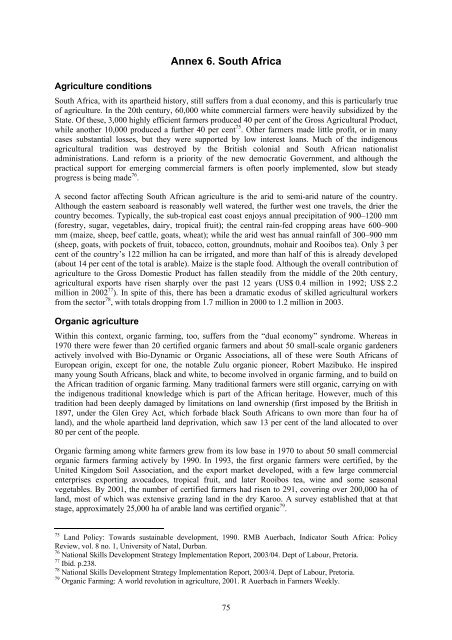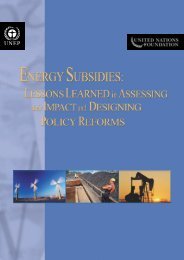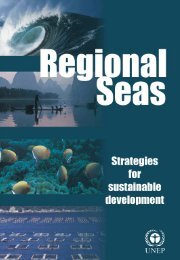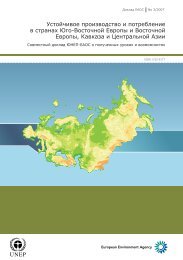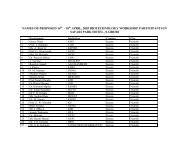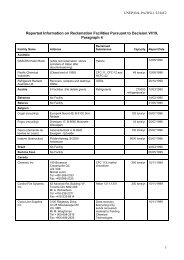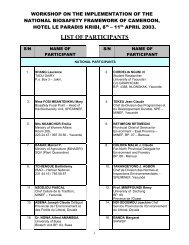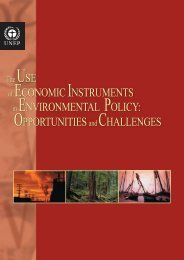Best Practices for Organic Policy - What developing country - UNEP
Best Practices for Organic Policy - What developing country - UNEP
Best Practices for Organic Policy - What developing country - UNEP
Create successful ePaper yourself
Turn your PDF publications into a flip-book with our unique Google optimized e-Paper software.
Agriculture conditions<br />
Annex 6. South Africa<br />
South Africa, with its apartheid history, still suffers from a dual economy, and this is particularly true<br />
of agriculture. In the 20th century, 60,000 white commercial farmers were heavily subsidized by the<br />
State. Of these, 3,000 highly efficient farmers produced 40 per cent of the Gross Agricultural Product,<br />
while another 10,000 produced a further 40 per cent 75 . Other farmers made little profit, or in many<br />
cases substantial losses, but they were supported by low interest loans. Much of the indigenous<br />
agricultural tradition was destroyed by the British colonial and South African nationalist<br />
administrations. Land re<strong>for</strong>m is a priority of the new democratic Government, and although the<br />
practical support <strong>for</strong> emerging commercial farmers is often poorly implemented, slow but steady<br />
progress is being made 76 .<br />
A second factor affecting South African agriculture is the arid to semi-arid nature of the <strong>country</strong>.<br />
Although the eastern seaboard is reasonably well watered, the further west one travels, the drier the<br />
<strong>country</strong> becomes. Typically, the sub-tropical east coast enjoys annual precipitation of 900–1200 mm<br />
(<strong>for</strong>estry, sugar, vegetables, dairy, tropical fruit); the central rain-fed cropping areas have 600–900<br />
mm (maize, sheep, beef cattle, goats, wheat); while the arid west has annual rainfall of 300–900 mm<br />
(sheep, goats, with pockets of fruit, tobacco, cotton, groundnuts, mohair and Rooibos tea). Only 3 per<br />
cent of the <strong>country</strong>’s 122 million ha can be irrigated, and more than half of this is already developed<br />
(about 14 per cent of the total is arable). Maize is the staple food. Although the overall contribution of<br />
agriculture to the Gross Domestic Product has fallen steadily from the middle of the 20th century,<br />
agricultural exports have risen sharply over the past 12 years (US$ 0.4 million in 1992; US$ 2.2<br />
million in 2002 77 ). In spite of this, there has been a dramatic exodus of skilled agricultural workers<br />
from the sector 78 , with totals dropping from 1.7 million in 2000 to 1.2 million in 2003.<br />
<strong>Organic</strong> agriculture<br />
Within this context, organic farming, too, suffers from the “dual economy” syndrome. Whereas in<br />
1970 there were fewer than 20 certified organic farmers and about 50 small-scale organic gardeners<br />
actively involved with Bio-Dynamic or <strong>Organic</strong> Associations, all of these were South Africans of<br />
European origin, except <strong>for</strong> one, the notable Zulu organic pioneer, Robert Mazibuko. He inspired<br />
many young South Africans, black and white, to become involved in organic farming, and to build on<br />
the African tradition of organic farming. Many traditional farmers were still organic, carrying on with<br />
the indigenous traditional knowledge which is part of the African heritage. However, much of this<br />
tradition had been deeply damaged by limitations on land ownership (first imposed by the British in<br />
1897, under the Glen Grey Act, which <strong>for</strong>bade black South Africans to own more than four ha of<br />
land), and the whole apartheid land deprivation, which saw 13 per cent of the land allocated to over<br />
80 per cent of the people.<br />
<strong>Organic</strong> farming among white farmers grew from its low base in 1970 to about 50 small commercial<br />
organic farmers farming actively by 1990. In 1993, the first organic farmers were certified, by the<br />
United Kingdom Soil Association, and the export market developed, with a few large commercial<br />
enterprises exporting avocadoes, tropical fruit, and later Rooibos tea, wine and some seasonal<br />
vegetables. By 2001, the number of certified farmers had risen to 291, covering over 200,000 ha of<br />
land, most of which was extensive grazing land in the dry Karoo. A survey established that at that<br />
stage, approximately 25,000 ha of arable land was certified organic 79 .<br />
75 Land <strong>Policy</strong>: Towards sustainable development, 1990. RMB Auerbach, Indicator South Africa: <strong>Policy</strong><br />
Review, vol. 8 no. 1, University of Natal, Durban.<br />
76 National Skills Development Strategy Implementation Report, 2003/04. Dept of Labour, Pretoria.<br />
77 Ibid. p.238.<br />
78 National Skills Development Strategy Implementation Report, 2003/4. Dept of Labour, Pretoria.<br />
79 <strong>Organic</strong> Farming: A world revolution in agriculture, 2001. R Auerbach in Farmers Weekly.<br />
75


